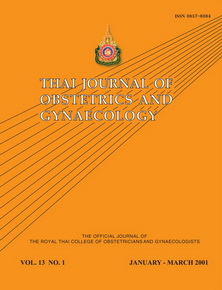Hypertrophic Cesarean Section Scarring: Polyglycolic acid and Nylon Sutures in a Randomized Trial
Main Article Content
Abstract
Objective To compare the incidence of hypertrophic scar between polyglycolic acid (PGA) and
nylon sutures in cesarean section.
Design Prospective study.
Setting Department of Obstetrics and Gynecology, Faculty of Medicine, Ramathibodi
Hospital, Mahidol University.
Subjects In 62 patients undergoing primary cesarean section, 32 patients were closed with
subcuticular PGA suture and 30 patients were closed with interrupted nylon suture.
Main outcome measures Measurements of the hypertrophic scar was made at 6 months after
surgery.
Results Thirty-two of the 32 patients (100 percent) closed with subcuticular PGA suture and
sixteen of the 30 patients (53 percent) closed with interrupted nylon showed hypertrophy.
Conclusion The use of PGA suture subcuticularly has higher incidence of hypertrophic scarring
in cesarean section wound than that use of nylon suture interruptedly.
nylon sutures in cesarean section.
Design Prospective study.
Setting Department of Obstetrics and Gynecology, Faculty of Medicine, Ramathibodi
Hospital, Mahidol University.
Subjects In 62 patients undergoing primary cesarean section, 32 patients were closed with
subcuticular PGA suture and 30 patients were closed with interrupted nylon suture.
Main outcome measures Measurements of the hypertrophic scar was made at 6 months after
surgery.
Results Thirty-two of the 32 patients (100 percent) closed with subcuticular PGA suture and
sixteen of the 30 patients (53 percent) closed with interrupted nylon showed hypertrophy.
Conclusion The use of PGA suture subcuticularly has higher incidence of hypertrophic scarring
in cesarean section wound than that use of nylon suture interruptedly.
Article Details
How to Cite
(1)
Roungsipragarn, R.; Somboonsub, O. Hypertrophic Cesarean Section Scarring: Polyglycolic acid and Nylon Sutures in a Randomized Trial. Thai J Obstet Gynaecol 2017, 13, 19-21.
Section
Original Article


